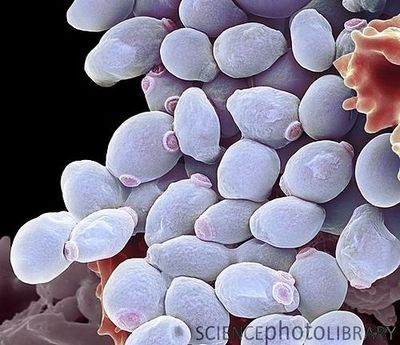Candida albicans (Pathogenesis)


Etiology/Bacteriology
Taxonomy
| Domain = Eukaryota | Phylum = Ascomycota | Class = Saccharomycetes | Order = Saccharomycetales | Family = Saccharomycetaceae | Genus = Candida | species = albicans
|
NCBI: Taxonomy Genome: Candida albicans |
Description
Candida albicans is an opportunistic fungal pathogen that is responsible for candidiasis in human hosts. C. albicans grow in several different morphological forms, ranging from unicellular budding yeast to true hyphae with parallel-side wall [1]. Typically, C. albicanslive as harmless commensals in the gastrointestinal and genitourinary tract and are found in over 70% of the population. Overgrowth of these organisms, however, will lead to disease, and it usually occurs in immunocompromised individuals, such as HIV-infected victims, transplant recipients, chemotherapy patients, and low birth-weight babies [2]. There are three major forms of disease: oropharyngeal candidiasis, vulvovaginal candidiasis, and invasive candidiasis. Over 75% of women will suffer from a C. albicans infection, usually vulvovaginal candidiasis, in their lifetimes, and 40-50% of them will have additional occurrences(s). Interestingly, C. albicans are the 4th leading cause for nosocomial infections in patients’ bloodstreams. This could result in an extremely life-threatening, systemic infection in hospital patients with a mortality rate of 30% [3]. For oropharyngeal candidiasis, infection occurs in the mouth or throat, and is identified by white plaque growth on oral mucous membranes. Vulvovaginal candidiasis or a “yeast infection” is the overgrowth of C. albicans in the vagina, and results in rash, itchiness, and discharge from the genital region. Lastly, invasive candidiasis occurs when the fungal pathogen enters the bloodstream and can easily spread to organs throughout the body. Invasive candidiasis is best identified when antibiotics fail to cure a patient’s fever [4]. C. albicans infections are usually treatable with fluconazole, while severe infections require amphotericin B.
Pathogenesis
Transmission
Candida albicans is usually transmitted from mother to infant through childbirth, and remains as part of a normal human’s microflora. The overgrowth of C. albicans leads to symptoms of disease, and it occurs when there are imbalances – for example, changes in the normal acidity of the vagina. C. albicans infections very rarely spread through sexual intercourse. The typical reservoir for C. albicans is in the normal human microflora, and is not found in animal vectors [5]. People-to-people acquired infections mostly happen in hospital settings where immunocompromised patients acquire the yeast from healthcare workers; studies show about a 40% incident rate [6].
Infectious dose, incubation, colonization
There is no exact known infectious dose of Candida albicans. This is mostly due to the fact that a C. albicans infection stems from the commensal population of C. albicans in the human microflora. Candidiasis is caused by the abnormal growth in C. albicans, which is usually due to an imbalance in the environment. Usually, this imbalance occurs in a woman’s vagina – this infection less likely to occur for men. Several events can spark an imbalance. For example, antibiotic use can decrease the amount of lactobacillus bacteria, which decreases the amount of acidic products and the pH of the vagina. Other events are pregnancy, uncontrolled diabetes, impaired immune system, and irritation of the vagina. C. albicans are able to take advantage of the conditions and outcompete the normal microflora, resulting in candidiasis or a yeast infection [7].
Epidemiology
United States
In the United States, oropharyngeal colonization by Candida albicans can be found in almost 30-55% of young adults. Also, the presence of C. albicans is detected in about 40-65% of normal fecal samples [8]. Overall, C. albicans infections remain as the top source of fungal infections in immunocompromised people. For example, in HIV compromised patients, over 90% will develop a case of oropharyngeal candidiasis [9]. On the other hand, about 75% of women experience vulvovaginal candidiasis, and about 40-50% will experience more than one episode.
In addition, candidemia is the fourth most common bloodstream infection in the United States. Almost 6.9 out of every 1000 intensive care unit patients are suffer from candidemia [10].
Worldwide
Rates for candidiasis and candidemia are similar throughout the world [8].
Virulence factors
Polymorphism
Candida albicans is a polymorphic fungus that can grow in several different forms, primarily yeast, pseudohyphae, and hyphae. For its pathogenicity, its ovoid-shaped budding yeast and parallel-walled true hyphae forms are the most important. The hyphae form is more prevalent for an infection, while the yeast form is believed to be important in the spread of C. albicans. The role of pseudohyphae is not very well understood, other than being an intermediate form between yeast and hyphae [1]. Several factors can cause a change in morphology, such as pH differences, temperature changes, carbon dioxide levels, starvation, and quorum-sensing molecules (farnesol, tyrosol, and dodecanol) [11].
Clinical features
Symptoms
Morbidity and Mortality
Diagnosis
Treatment
Prevention
Host Immune Response
References
1. Sudbery P, Gow N, Berman J. 2004. The distinct morphogenic states of Candida albicans. Trends in Microbiology. 12(7):317-24.
2. Kabir MA, Hussain MA, Ahmad Z. 2012. Candida albicans: A Model Organism for Studying Fungal Pathogens. ISRN Microbiology. 2012: 538694.
3. Pfaller MA, Diekema DJ. 2007. Epidemiology of Invasive Candidiasis: a Persistent Public Health Problem. Virulence. (2): 119–128.
4. Centers for Disease Control and Prevention. Candidiasis. [<http://www.cdc.gov/fungal/diseases/candidiasis/index.html/>].
5. Public Health Agency of Canada. Candida albicans - Material Safety Data Sheets. [<http://www.phac-aspc.gc.ca/lab-bio/res/psds-ftss/msds30e-eng.php>].
6. Fanelloa S, Boucharab JP, Jousseta N, Delbosa V, LeFlohicc AM. 2001. Nosocomial Candida albicans acquisition in a geriatric unit: epidemiology and evidence for person-to-person transmission. Journal of Hospital Infection. 47(1):46-52.
7. Mayo Clinic. Diseases and Conditions: Yeast infection (vaginal). [<http://www.mayoclinic.org/diseases-conditions/yeast-infection/basics/definition/con-20035129>].
8. Hidalgo JA, Vazquez JA, Bronze MS. 2014. Candidiasis: Frequency. [<http://emedicine.medscape.com/article/213853-overview#aw2aab6b2b3aa>].
9. de Repentigny L, Lewandowski D, Jolicoeur P. 2004. Immunopathogenesis of oropharyngeal candidiasis in human immunodeficiency virus infection. Clinical Microbiology Review. 17(4):729-59.
10. Mikulska M, Bono VD, Ratto S, Viscoli C. 2012. Occurrence, Presentation and Treatment of Candidemia. Expert Review of Clinical Immunology. 8(8):755-765.
11. Mayer FL, Wilson D, Hube B. 2013. Candida albicans pathogenicity mechanisms. Virulence. 4(2): 119–128.
Created by Johnson Ong, a student of Tyrrell Conway at the University of Oklahoma.
